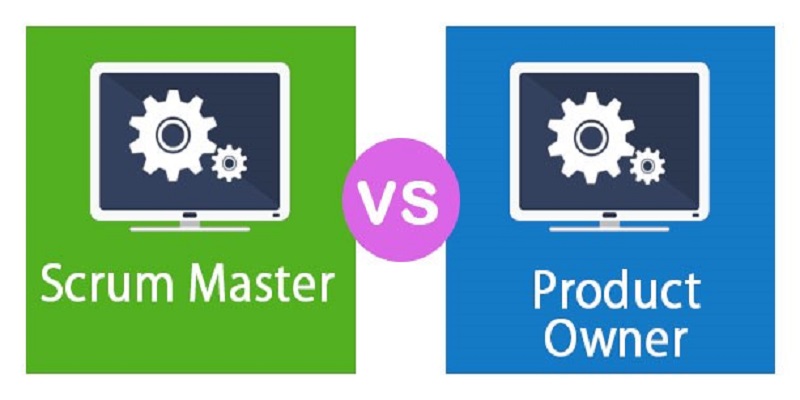Difference Between the Scrum Master and the Product Owner

In the Management of the Product and its development, each person engages indefinite roles. Despite that, people tend to mix the roles of contrasting team members. If you observe how the Scrum Master vs. Product Owner is portrayed, you will understand that these roles are still ambiguous for too many people.
However, it’s not your fault if you don’t understand the difference in their roles. Both roles are relatively niche-based, and many non-product-based people have a slight idea about them. Well, worry not; we are here to walk you through these roles to make you understand them bit by bit.
In this article, we shall scrutinize the Scrum Master vs. Product Owner plot and emphasize their differences.
Common, let’s check it out.
Scrum Master Job Description
Scrum Masters are part of the trifecta that come under the Scrum Team, which includes Scrum Master, the Product Owner, and the Team. Scrum Masters play their part by making sure the Scrum Approach is implemented during product and software development.
The Scrum Process is based on the Scrum Framework, and the framework is a work of art designed in a way by using the Agile Methodologies. Moreover, the familiarity of the Scrum Guide is fundamental in the Scrum Team, Scrum Methodology, and all the Scrum Events.
In some cases, Scrum Masters also usher team operations with practices such as Kanban. Using these methods, they certify the delivery of all complications, appeals, events and enhance the capabilities of people. Scrum Masters also have to satisfy cross-departmental coordination roles. They may include release coordinator and change coordinator, among the others.
Furthermore, Scrum Masters continually increase team efficiency and recommend changes to the product vision, roadmaps, and even the backlog. They even help develop a more efficient process for the development and engineering teams.
Supervision is one of the most critical roles of the Scrum Master. Therefore they must live by the Agile Practices and follow and complete all daily Scrum activities. They also usually need to have a Scrum Master Certification from reputable organizations.
Product Owner Job Descriptions
Another part of the trifecta is the role of the Product Owner. However, the role of the Product Owner is often misunderstood with that of a Product Manager.
Product Owners are responsible for utilizing the Agile Development approach to ensure the correct product completes development. A large part of their job involves meticulous planning on their part. And a clear vision is needed for that planning, which is being done to emphasize the product’s value.
As a result, Product Owners develop the product vision using client stories, approaches, research, and product and business requirements.
The Product Owner is often keen on managing the product backlog, which includes all the past and current features of the same product. The changes that were made along the way are maintained in a list. A considerable part of their job description includes Product Backlog Management. In a way, keeping the update on the product backlog helps the Product Owner to ensure the correct product is released.
Furthermore, they’re the first in line to get the release date. While Product Owners can’t seamlessly control the product’s release, they can call for enactment, pause, or cancellation of release based on the feedback given.
Another part of their job is learning Sprint Planning and Management of Product. You can consider sprints as prototypes of products. Sprints help you realize whether the feature updated from the past or current backlog is suitable for the product or not. Moreover, it also tells you where the changes are needed to be made and whether the product is ready to be released.
Product Owners make sure that a foolproof vision, roadmap, and management of the product with strategies is done before the successful products make it to the market.
If you are interested in learning the exact process of making successful products as a product owner, you can take a look at this PSPO certification course.
Scrum Master vs. Product Owner – Skills Comparison
While both the Scrum Master and Product Owner are part of the Scrum Team, a diversified skill set is required to fill in their shoes.
Scrum Master Skills
The skills required to be a Scrum Master are as follows.
- Leadership Skills: Helps remove hindrances to ensure the team stays right on track. They also eliminate unwanted distractions to ensure the Scrum Practices were followed to the last word.
- Collaborator: A good Scrum Master is always aware of all activities, meetings, and sessions within the office space; this quality comes from being the best collaborator. A true team player.
- Coaching and Mentoring Abilities: Being a team player means that if your team faces any hindrances, you should be the one who helps and mentors them to get them out of it.
- Communication Skills: Being a mentor and team player brings out communication skills. Scrum Masters are excellent at listening. They can help their team out in a time of distress, plan ahead of time, do customer research, strategize activities accordingly.
- Ready for Change: The role of Scrum Master makes them practically ready for change, as it becomes part of their job. To adapt, change process, redo becomes the daily routine. Moreover, helping their team members through change is part of their job profile.
- Certifications and Knowledge: Scrum Masters should have proper certification and knowledge associated with Product Management and Scrum Approach.
Product Owner Skills
The skills required to be a Product Owner are as follows.
- Committed to Vision: Product Owners need to be able to interact with the vision of the product with all its stakeholders. That incorporates the product backlog, other auxiliary requirements, and vision-related processes.
- Constant Availability: The consultation between the Product Owner and the development team is high because the Product Owner has structured out the product plan completely. Therefore he needs to be available to them at all times and open to communication.
- Understanding of ROI: Product Owners are responsible for the product’s success and thus focus all their energy on its production. They are responsible for ensuring that ROI stays positive in the end.
- Technical Skills: The Product Owner needs to know everything that has to do with software development to product marketing.
- User Side Perspective: Since the ability to think of the big picture, the Product Owner has to develop their vision and processes from a user-side perspective. To explain to his team.
Scrum Master vs. Product Owner – Comparison of Responsibility
In small companies, the responsibilities of the Scrum Master and the Product Owner may overlap or coincide with each other. However, in predominantly large companies, their roles are very distinct.
Scrum Master Responsibilities
Following are the responsibilities of the Scrum Master
- The Scrum Master manages the Scrum processes while synchronizing with the Scrum Team.
- They improve the efficiency of the development, engineering, and the Scrum team when obstacles hinder their progress.
- Scrum Masters arrange daily stand-up meetings and facilitate other meetings, demos, and decision-making processes.
- Scrum Masters help conduct Sprint Review in retrospect to meetings and also help in facilitating the Sprint Planning meeting.
- They also help the Product Owner create and maintain the product backlog. They help make the Sprint Backlog ready for the next sprint.
Other than this, Scrum Masters also act accordingly to the Scrum Guide, coach its team, and solve conflicts within the team.
Moreover, they also help the team manage project risks.
Product Owner Responsibilities
Following are the responsibilities of the Product Owner
- The product Owner attends sprint demos, sprint planning meetings, and daily scrums.
- They help develop the product vision, form deadlines, and define and strategize feature priorities.
- Product Owners help determine the product’s release date and recheck the content of the project.
- Product owners have to fulfill their Scrum Role by continuously communicating with the Scrum Master.
- They are responsible for prioritizing the user stories with/her team members.
The Product Owner has to be naturally curious and always focus on the ‘why’ and ‘how.’ Once you get your answers, the Product Owner explains the concept to the rest of the team.
Scrum Master vs. Product Owner – Use of Agile Methodology
Many companies on a small scale tend to ask whether the Product Owner can be the Scrum Master or vice versa. The answer is simply a NO.
The leading cause for that is that it creates a conflict of interest. Product Owners are responsible for making a vision and a plan see-through. In other words, to make a product successful. While Scrum Masters have to oversee the entire process and make sure it’s coherent and pertinent at the same time. As a result, Scrum Master reviews the Product Owners work and provides couples that advocate for improvements or best practices.
Thus both jobs require different people for separate perspectives and scope of growth and stop coinciding with each other.
To use Agile Methodology, You need both people, the Scrum Master, and the Product Owner.







